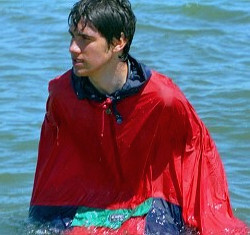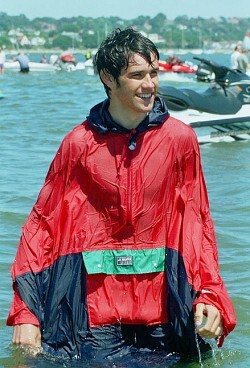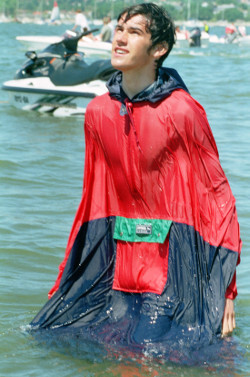Hiking Cape Design
Hiking capes are longer in the back to cover a rucksack. They often have short sleeves, which may be good for swimming, but give less rain cover unless you pull your arms inside.
Better hiking capes have long sleeves that cover your arms to protect you better. They look like cagoules but have a wider cut and more length. Great for hiking, cycling, or adventure swimming.
Many hiking ponchos are actually rain capes, some even have long sleeves. They are closed on the side and look more like oversized cagoules or anoraks.
Hiking capes don't have a long leaky row of boring buttons on the front like many rain coats. Instead they are closed all round. That makes them less bulky and thus more fun to wear.
While ponchos are open on the sides, rain capes are closed all round, with hand or arm openings on the sides with short or long sleeves, so you can safely swim in them.
Hiking capes are cylinder shaped and should reach below the knees for best cover.
The better ones have a toggle so you can pull the front up when you walk up steep tracks.
Main Features
- Low weight, fashionable and practical
- T-shape with long or short sleeves
- Closed sides for good rain, sun and wind protection
- Front zip vent keeps you cool when it gets too hot
- Spare swimsuit dries faster than your shorts


Front Pocket
Instead of a full length front zip or button row, many hiking capes have a useful roomy kangaroo-style front pocket into which you can pack your rain cape and stow it in your luggage or daypack. You can also pull out the waist straps from inside the pocket and wear it as a fanny pack around your waist.
During a heavy downpour, or when swimming, water may get into the front pocket which usually doesn't have drain holes. Bear that in mind when you put something like a mobile phone in there. For short walks in the rain the waterproof front pocket may be all you need to carry a snack or such.


Dry Backpack
For longer trips you may want a backpack which will stay dry underneath your rain cape. Some hiking ponchos have an extension for your backpack that folds out when needed. They are specially designed with flaps that can be extended to cover you and your backpack.
The bottom edge of the poncho may have a shock cord fitted to enable the poncho to be pulled around the bottom of a backpack and tied off around the wearer's waist for security in windy conditions.
The one drawback for the fashion conscious hiker is that hiking ponchos can look a bit unattractive when worn over your backpack. You will end up looking like a hunchback. Oh well, a small price to pay.
Sizing
Measure from top of your shoulders down your front and back, as far as you want it to drape.
Longer is better.
Look for lots of length and width to cover you whole body.
Hiking capes should reach below your knees.
Most have a way to button up the front for when you hike uphill.
The arms are fully covered by better rain capes.
If they are too short your arms get wet everytime you reach out.